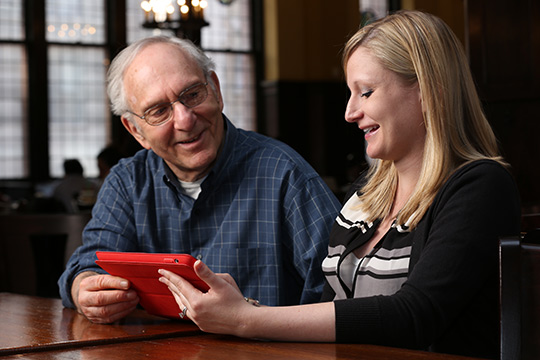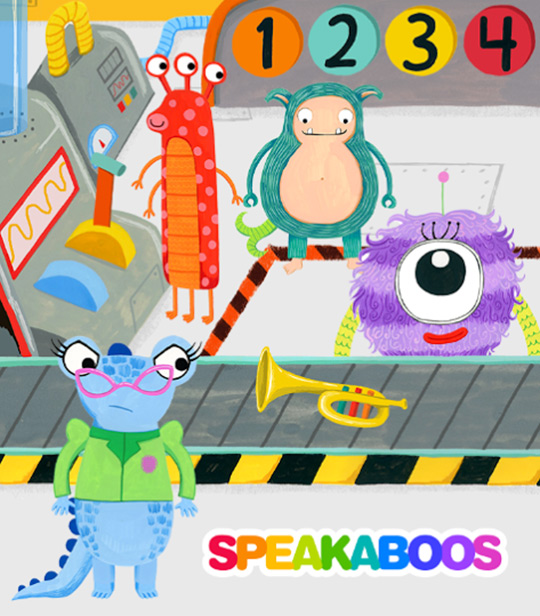Children's Stories that Count: Math for the very young, courtesy of some of TC's best minds
Children love stories. Children love counting. Wouldn’t it be great if someone created really good interactive stories that reside on touch-screen tablets and that help kids to learn to count and engage in various mathematical activities?
Someone has, and not just any someone. In mid-April, Teachers College cognitive developmental psychologist Herbert Ginsburg, whose research has helped establish that toddlers as young as 18 months can do “everyday math,” joined forces with TC alumna Alice Wilder (Ed.D. ’98), producer of the hit children’s TV show “Blues Clues,” to launch a new line of touch-screen math learning stories through Speakaboos, the education technology start-up focused on reading motivation for which Wilder serves as chief learning officer. Ginsburg’s recent doctoral student, Samantha Creighan (Ph.D. ’14), who works for Speakaboos, is the project’s supervising producer. The project is funded by the Heising-Simons Foundation, and a host of other partners are involved, including the Sesame Street composer, creator of video features and writer Christopher Cerf; FlickerLab, an animation and software company; and a cast of veteran Sesame Street actors and voiceover artists.
Ginsburg’s new stories for Speakaboos draw on the MathemAntics software he developed several years ago, which helps children learn ideas about numbers (for example, that the last number counted designates how many objects there are in total), and strategies like subitizing (quick identification of a number by looking rather than counting) and grouping (determining the number of objects by placing them into convenient groups), and operations on number, like addition and subtraction. In the “Monster Music Factory” story, for example, three critters – one-eyed Oona, two-eyed Marluk and three-eyed Tigga – assemble quantities of instruments for a band that’s about to put on a big show. In the “read & play” mode, for the story, children explore mathematical ideas, employ strategies to solve problems, and advance the narration by pulling levers to make the requisite numbers of musical instruments. They can also click on different characters and objects for additional math-related activities. Two other math interactive storybooks are on their way.
“My goal is to make it fun and have a lot of learning, so the technology and interactivity are always used to enhance the learning experience, rather than distract from it,” says Ginsburg, TC’s Jacob H. Schiff Foundations Professor of Psychology & Education. “And the story is always about the math in an important way. Let’s get the right number of instruments. Why didn’t it come out right? Because Oona took a trumpet,, which is a mischievous form of subtraction.”
Ginsburg, who has studied the math thinking and play of countless young children, began work on the Speakaboos stories as a result of a Heising-Simons initiative that has brought together experts from across the country to improve early math education. As part of that effort, he and others are developing tools to provide real educational content in informal daycare settings where TV and other screen devices are often the default option.
“We know that kids are going to be on these devices, and that’s OK if you can give them content that’s high-quality, educational and entertaining,” says Wilder, who also co-created PBS Kids’ SuperWHY! and recently won an Emmy Award in her role as Co-Executive Producer and Head of Educational Development for Tumble Leaf, part of Amazon Kids Original Programming. “Technology has so much value for learning, because it can take really abstract and difficult concepts and make them visual and concrete – especially with math. It also allows for pausing and repetition. We do all of that, and we ground it in learning theory, kid testing, production and interactive technology practices, research on child development and literacy, and Herb’s math research. That’s what really sets us apart in the education technology space.”
Because Ginsburg’s stories are “scaffolded” for readers of different abilities, they also address what Creighan calls “the reading proficiency gap.”
“There’s a huge variation in reading proficiency in young children, driven by differences in SES, language and motivation,” Creighan says.
“I was a struggling reader myself as a kid,” adds Wilder. “So my goal even before coming to TC was to play the role of Tom Hanks in the movie ‘Big’ by being the adult in the room who thought like a kid and could translate what appeals to kids, what they understand, and blend that with important skills and learnings to make create products that positively affect their lives. With all the great minds on this project, we’re really doing that.”
Ginsburg’s math stories – part of the 160-story Speakaboos digital library – are accessible via a Speakaboos app that can be downloaded through the Apple Store and Google Play; the Speakaboos website; and YouTube. Speakaboos is free to download and comes with unlimited access for one week followed by a $4.99 monthly subscription fee. The stories can be played on iPhones, Nabi tablets and other devices. – Joe Levine
Published Wednesday, May. 27, 2015

